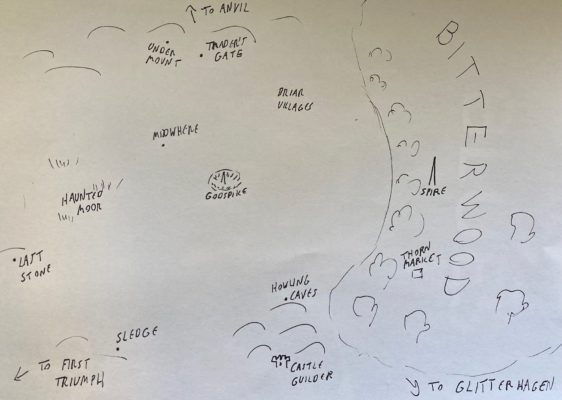13th Age, News, See Page XX
The Book of Sandboxes
Talk is again turning in Pelgrane Towers to my infrequently-written 13th Age campaign, Prophet of the Pyre, and when I’ll actually get around to delivering it. The first third of the campaign is set in a self-contained valley in the mountains, and that concept of the local sandbox can be useful tool for a 13th Age campaign. Instead of running around the whole Dragon Empire, you can take one small location – one city, say, or one region, or even one little unremarkable square of the map – and make it your own.
The Book of Ages offers the Engine of the Ages, a tool to build up a shared history for your 13th Age campaign, and that tool can be adapted to create a shared little pocket sandbox, too.
Pick Your Sandbox
First, pick where your campaign’s going to be set, and draw a very very rough sketch map of its borders and major geographical features. If you’re setting your game in, say, the city of Glitterhaegen, then sketch out the city walls, the harbour, the coast, and the hinterland. If your game is in the Owl Barrens, then trace the edges of that wilderness.
Decide on the Factions
Next, each player picks one major faction associated with the setting. It works best if the faction is connected to the player’s character – so, if Bob’s playing a Human Wizard, then Bob’s faction is the Wizards of Glitterhaegen – but a player can pick something unconnected or bizarre if they prefer. The GM takes as many factions are desired – 3-4 is usually plenty.
Assign Landmarks
Landmarks come in four types:
- Strongholds are places where that faction is especially strong and secure. It doesn’t have to be a literal stronghold; it might be a neighbourhood where that faction has lots of influence, or a wellspring of magical energy that aids the faction.
- Flashpoints are places where the faction is likely to come into conflict. It could be a spot where the faction clashes with another (“here’s where the wizard district brushes up against dwarftown”), a source of danger (“there’s a were-owl lair here!”) or an objective the faction seeks to capture.
- Crossing Points are places were the faction works with/trades with/is otherwise entangled with another faction.
- Ruins are spots that were once associated with the faction, but are now abandoned/derelict/otherwise unavailable.
Each player faction gets a number of landmarks based on the size of the map you’re going for – 3 to 5 is a good number, but you can add more if you want to do a really sprawling sandbox. The GM gets the same number of landmarks, but splits them among all the GM factions.
Determine the nature of each landmark randomly by rolling a d6.
(1: Flashpoint 2-3: Stronghold 4-5: Crossing Point 6: Ruin).
Fill The Sandbox
Next, go around the table and have each player place one of their faction’s landmarks. The GM should ask the player one or two evocative questions about that landmark to flesh out details.
For Example…
Alice, Bob and Cedric are going to play a 13th Age campaign set in the little circle of land north of First Triumph, south of Anvil and west of the Bitterwood. Alice is playing a Dwarf Commander, Bob’s playing a Human Occultist, and Cedric’s playing a Half-Elf Bard.
The factions chosen, and their associated landmarks, are
| Alice | Dwarves | Crossing Point, Stronghold, Ruin |
| Bob | Fate Ghosts* | Flashpoint x2, Crossing Point |
| Cedric | Briar Elves of the Bitterwood | Flashpoint, Stronghold, Crossing Point |
| GM | Crusade | Stronghold |
| Glitterhaegen | Stronghold | |
| Giants | Crossing Point |
*GM: “What’s a fate ghost, Bob?” Bob: “I dunno. It sounds cool.”
Round 1
Alice puts down her Crossing Point – the Trader’s Gatehouse, a massive trading post/customs checkpoint/fortress on the road between Anvil and Glitterhaegen. The GM quibbles that the Gatehouse sounds more like a stronghold, and Alice clarifies that the Gatehouse is rotten and full of the Prince of Shadow’s agents.
Bob puts down the first of his two Flashpoints – the Haunted Moor. He explains that Fate Ghosts are the shades of the neverwas; they’re from alternate Ages, alternate realities. They’re the ghosts of people who once existed, but then got erased by mysterious cosmic forces. There was once a great city on the haunted moor, but not in this Age.
Cedric puts down his Stronghold – the Spire of Ten Thousand Thorns, a prison tower where the Briar Elves keep their captives. Cedric’s planning on playing a rogue Briar Elf whose long-term goal is to rescue his true love from the topmost level of the tower. The GM asks who the master of the Spire is, and Cedric decides it’s the Rose Princess, the estranged daughter of the Elf Queen.
The GM puts down the Crusade’s stronghold – a former Hellhole called Godspike. It’s right in the middle of the region – and it’s cracked, spilling demons out at random, plot-convenient moments.
Round 2
 This round, Cedric goes first. He decides that the Briar Elves have been kidnapping travellers on the road near the Trader’s Gatehouse – a Flashpoint. There are villages there inhabited by magic briar-plant duplicates of their kidnapped victims. The GM asks Cedric to decide if this is a new threat that the player characters don’t know about, or something that’s been going for years and is a known problem. Cedric goes for the latter – and Alice suggests that’s why the place is full of fortified places like the Trader’s Gatehouse. If that wandering merchant on the road might secretly be a thorny pod person, it makes sense for everyone to be paranoid and have all sorts of magical security precautions.
This round, Cedric goes first. He decides that the Briar Elves have been kidnapping travellers on the road near the Trader’s Gatehouse – a Flashpoint. There are villages there inhabited by magic briar-plant duplicates of their kidnapped victims. The GM asks Cedric to decide if this is a new threat that the player characters don’t know about, or something that’s been going for years and is a known problem. Cedric goes for the latter – and Alice suggests that’s why the place is full of fortified places like the Trader’s Gatehouse. If that wandering merchant on the road might secretly be a thorny pod person, it makes sense for everyone to be paranoid and have all sorts of magical security precautions.
The GM adds the Glitterhaegen stronghold: Castle Guilder, an absurdly huge and fanciful keep based on Neuschwanstein Castle – a fortress built by an impossibly wealthy eccentric noble, with its own opera house, endless secret passages, mystical towers full of alchemists and so much, much more. It’s a winter retreat for the nobles of Glitterhaegen, so lots of intrigue amid the hot port and the hunting expeditions.
Stung, Alice puts down the Dwarven stronghold – Undermount, a subterranean castle that guards an entrance to the Underworld. The GM asks Alice to come up with One Weird Thing about Undermount to give it some character, and she declares that Undermount’s sinking into the depths, dragged down by some supernatural force, and the dwarves keep adding new levels on top and abandoning the deepest stretches. The GM agrees that he also just bought Swords of the Serpentine and that Eversink is indeed awesome. Alice throws dice at the GM because he’s being an ass and she’s capable of having original ideas, thank you very much.
Bob adds another Flashpoint – the Howling Caves, a labyrinth of dimensionally-unstable caverns where you can travel between alternate realities. The Fate Ghosts guard these caves. The GM asks Bob to pick another faction that might want to go into the caves, and Bob declares that the caves are rich in precious metals and gems, and they’re an old dwarven mine.
Round 3
 Bob goes first this round again. His last landmark is his Crossing Point; he creates the village of Midwhere, a ‘reality oasis’ where the Occultist was born. It’s a village that exists across realities, so it’s full of weird visitors from other realms, living people who’d become Fate Ghosts if they leave, magical entities and the like. All this weirdness started when the Occultist was born, and Bob’s character is only fifteen years old, so Midwhere is a relatively new arrival in the area. The GM points out that ‘reality-warping village full of strange creatures’ might look like a Hellhole to the Crusade…
Bob goes first this round again. His last landmark is his Crossing Point; he creates the village of Midwhere, a ‘reality oasis’ where the Occultist was born. It’s a village that exists across realities, so it’s full of weird visitors from other realms, living people who’d become Fate Ghosts if they leave, magical entities and the like. All this weirdness started when the Occultist was born, and Bob’s character is only fifteen years old, so Midwhere is a relatively new arrival in the area. The GM points out that ‘reality-warping village full of strange creatures’ might look like a Hellhole to the Crusade…
Cedric’s last landmark is also a Crossing Point – he creates the Thorn Market, a fairy market where the cruel Briar Elves maintain a truce with the folk of Glitterhaegen. The GM asks Cedric to come up with something that the rich nobles of Castle Guilder might want from the Thorn Market, and Cedric decides that the elves can brew up all sorts of potent love potions and other spells of manipulation, which fit nicely with the intrigue and conspiratorial whirl of the castle.
The GM’s also left with a Crossing Point, for the hitherto-unmentioned Giants of the Giantswalk. There are already plenty of trade posts, so the GM goes for something different, and creates the Last Stone, an ancient monument to the spot where peace was agreed between the Empire and the belligerent giants many ages ago. Now, the Stone is the site of a regular contest of strength and wit between the giants and the little folk, to maintain and honour that long peace. (And, of course, the GM’s already planning the adventure arc where the stone’s destroyed and the war starts up again…)
Finally, Alice adds a dwarven ruin; the city of, uh, one sec, everyone’s looking up words that go with “Forge” and “Anvil”. Um, Tongs? Hammer? Ball-Peen? (more dice are thrown). Chisel? Hardy, says Cedric who’s found the Wikipedia page, and there’s a brief riff on dwarven detectives from the city of Hardy, the Hardy Boys. Eventually, they settle on Sledge. The GM makes jokes about Sledge Hammer!; the rest of the group stare at the ancient one who speaks of obscure media from before they were born, and the GM withers into dust.
Aaaaaanyway, the ruin of Sledge was once a great dwarven city, until it got sacked by giants in the war. And Something Mysterious happened, for the city vanished for age, then reappeared as a ruin, and it’s probably going to be connected to the Fate Ghosts and maybe there’s an alternate-reality version of Sledge out there that escaped destruction at the hands of the giants.



